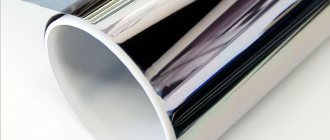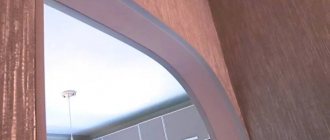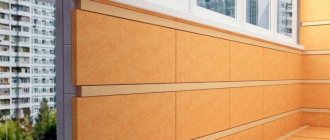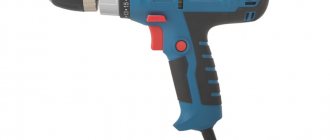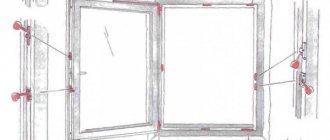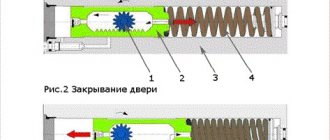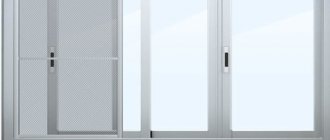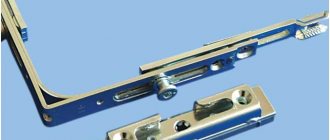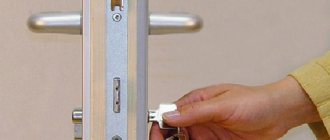- Posted by Svetlana Lukyanova
- Date: December 13, 2018
Modern materials have firmly entered our lives. Now we can’t imagine how we could do without adhesive tape, stretch film and other useful inventions. There is no longer any need to change doors that have lost their attractiveness and presentable appearance, because it is now possible to decorate them with self-adhesive film. This will not require large financial investments, but will radically transform the interior.
- 2 Advantages and disadvantages of self-adhesive material
- 3 How to properly cover a door with self-adhesive film
3.1 Preparing the door surface for applying self-adhesive film
- 3.2 Application of self-adhesive film
3.2.1 Video: applying self-adhesive film to complex surfaces
Types of universal self-adhesive film
The variety of self-adhesive finishes is so wide that choosing the right option simply by color would be a mistake. To effectively update your interior, you need to pay attention to the following characteristics:
- compound. Polyester, polyvinyl chloride or polypropylene are used as the basis for creating the canvas. Stabilizers, plasticizers and coloring pigments are added to them;
- coating structure. Single-layer and double-layer. Technical characteristics and strength are higher in the first option, and flexibility and ductility are higher in the second;
- surface type. The film is produced in matte, glossy, transparent (for glass), mirror and holographic with three-dimensional patterns;
- purpose. Pasting of any surfaces, from walls to furniture and doors.
Using self-adhesive film, you can update your interior on a budget.
The appearance of the coating has thousands of textures, colors and patterns. Conventionally, they can be divided into several types in accordance with the material they imitate:
- imitation of valuable wood species, including cork;
- solid or processed stone;
- porcelain stoneware, mosaics, tiles;
- film in the form of antique tapestries;
- coating imitating fabric or velor;
- children's theme: favorite cartoon characters, surface for drawing, writing with chalk and markers and all kinds of drawings.
An endless variety of structures, textures and colors provides a wide range of applications for the material in question.
Features of the material
To finally convince the reader of the rationality of using self-adhesive film for door decoration, the properties of the material should be examined in more detail. It has many advantages, but also has several disadvantages.
By and large, self-adhesive film is a polymer material, or rather a thin PVC film, on the back side of which there is an adhesive substance.
Why do you need self-adhesive?
Self-adhesive is used for complete repairs or for the restoration of outdated items, doors and furniture. The purpose of application may be to impart strength to various surfaces. For example, if wooden doors are installed in a bathroom, they need to be given moisture-resistant properties, and film is indispensable in this case.
Attention! When choosing a material for pasting, pay attention not only to the color, but also to the durability of the paints. Run your hand over the surface of the self-adhesive. If your palm is slightly stained, the paint will quickly rub off.
If you have made a renovation, radically changing the color scheme of the room, but you don’t want to change a door that doesn’t match the color, then self-adhesive will also come in handy.
Using self-adhesive film you can increase the moisture-proof properties of doors
Another area of application is protecting the door from scratches and damage of any kind.
Textile
Fabric fabric is also used to decorate old room doors.
The selected material can be used to cover the door entirely or partially. Using this method, a soft, cozy atmosphere of the room is created, of course, if the work is done carefully. You can fix the fabric on the door using PVA glue, liquid nails, double-sided tape or furniture staples. Before covering the door with fabric, the canvas must be primed for better adhesion of the material to the surface. As a primer, you can use simple wallpaper glue diluted in water to a liquid state.
To decorate the door with fabric, first make a pattern according to the exact measurements of the door leaf with a small (1-2 cm) overlap at the hem. Apply double-sided tape or apply an even layer of glue around the perimeter of the door. All that remains is to glue the cut fabric onto the door, after making a fold along the edges.
Often, covering a door with fabric is done using the patchwork technique. For this, several fragments of different colors, patterns and textures of the material are selected.
Fabric is a rather capricious material. The disadvantages of this method include the fact that traces of glue may appear through the material. Therefore, it is better to choose thick, dense fabrics with a pattern.
Film Specifications
Most often, cladding is sold in the form of rolls 15 m long. Their width can vary significantly. For large areas and flat surfaces, for example, for a door leaf, the widest rolls – 900 mm – are suitable.
If you need to cover a piece of furniture, it will be impractical to cut a wide canvas, so it is better to use a 450 or 675 mm coating.
For painstaking pasting of small objects or limited surfaces, a roll with a width of 53 or 106 mm is useful.
Film is usually sold in rolls
Pasting process
The film is glued to the surface from which all fittings and fasteners have been removed. Before gluing the PVC coating on interior doors, the canvas is removed from the hinges and placed horizontally. This is necessary for more comfortable carrying out the subsequent stages of surface finishing work.
As a rule, a scale in centimeters is printed on the back of the film. This helps to cut the material more accurately. However, it is always worth leaving a small margin of a few centimeters.
The pasting process itself must be carried out with extreme caution, and haste in this case can only do harm. The protective layer of paper is removed from the entire template at once. The film for the doors is laid on the prepared canvas and smoothed out on the sides with leisurely movements. The presence of air bubbles is strictly unacceptable. But if they do occur, then using an ordinary needle you need to make a tiny puncture, and air can be released through the resulting hole.
Particular care must be taken to press the ends of the doors so that the film lays firmly on all corners, creating the appearance of a kind of monolithic covering. Excess allowance must be carefully cut off using a regular or stationery knife. Since the finishing film has already been applied to the canvas, the procedure for attaching locks and door handles should be performed with the utmost care.
The film is available for sale in a wide range of colors and imitation of various wood textures. Due to its plasticity, PVC film lies perfectly flat on the door leaf and is pressed after applying little effort. PVC-coated doors on sale almost 100% replicate the texture of natural wood or marble.
How to cover a door with self-adhesive film. Preparation
As practitioners admit, restoring a door with self-adhesive is more convenient than painting it. Film, unlike paint, will hide unevenness and scratches. In addition, it does not smell and you do not need to wait for the surface to dry.
The most difficult preparatory stage is the choice of material.
Advice. For doors that often get dirty, you can use dark colors. A matte finish is better than a glossy finish because it doesn't show fingerprints.
The denser the material for pasting, the better. The tightness can be checked by bending one corner. If the film quickly returns to its original position, then it is thick enough.
To cover doors, it is necessary to use thick types of film.
Design Features
When choosing a self-adhesive film for a door leaf, you need to think carefully about the design. The features of this material allow you to give preference to the option that fits perfectly into the existing design of the room or hallway.
When facing a straight door, it is rational to use either a plain film or a patterned one. For panels you can use more complex combinations. Each of these sections of the door leaf can be finished in its own shade. It is important to take into account the interior features of the room. An undoubted advantage of this gluing technology is the ability to cover each side of the door differently. For consumers with a rich imagination, self-adhesive film for doors with a photo printed on it is perfect.
In addition to the door leaf, this material effectively decorates the frame, trim, and opening. Moreover, you can use either an identical film or some contrasting option. Not least important is the type of surface of the material. The glossy self-adhesive film is easy to clean and wash, and it also has original glare and reflections. And matte looks more aesthetically pleasing, nobler and hides fingerprints.
Pasting technique
To work you will need the following tools:
- stationery knife. It is more comfortable to hold than a blade;
- paper scissors;
- sandpaper for surface preparation;
- putty intended for wooden surfaces;
- putty knife;
- two rags: wet and dry.
Pasting instructions are usually printed on the back of the film
Step-by-step instruction:
- Sand the door leaf with sandpaper.
- Fill cracks and dents with putty. After drying, sand the top layer.
- Remove the handle and glass. The surface must be absolutely flat.
- Unwind the required length from the roll. There is no need to cut it; while applying the canvas, the roll will simply be under the door.
- Carefully remove some of the paper covering the adhesive layer. Apply the adhesive evenly to the top of the door.
- Slowly pull the paper down. As the glue opens, smooth the film so that wrinkles do not form. If air bubbles appear, you can simply pierce them with a needle.
- When you get to the bottom of the door, you need to cut it tightly with a utility knife.
- If there are any un-glued strips on the side, they can be cut or folded. The second option is more convenient if you cover the door with film on both sides.
The whole process can take from 10 minutes. up to an hour. After finishing the work, install a handle on the door and use it immediately.
Self-adhesive film is a simple, convenient and cheap way to transform your interior.
Required Tools
Before proceeding to pasting the door, you need to prepare the fixtures. To work you may need:
- ruler, metal corner and measuring tape (marking);
- pen or marker (outlining contours);
- scissors or construction knife (cutting film);
- rubber spatula (leveling the pasted coating);
- sprayer with water (adjusting the position of the self-adhesive);
- hair dryer (processing corners and protrusions).
If the door leaf needs preparation, then you need to prepare sandpaper or a sander, a plane, primer and putty.
Self-adhesive film for doors - photo
Self-adhesive film for doors
What will help beginners?
Before covering an old door with self-adhesive film, it needs to be well treated and cleaned. How to help inexperienced craftsmen? If something goes wrong, correction is made immediately. The easiest way to paste is on a metal or glass surface. When something is broken, a small amount of water helps to level the surface and bring it to perfection.
For ease of work, there is a special marking on the left side, which makes it easier to measure everything accurately. After creating the desired surface, the door is left for half an hour for the adhesive base to completely dry. Then the handles are put in place and the entire structure is fixed.
